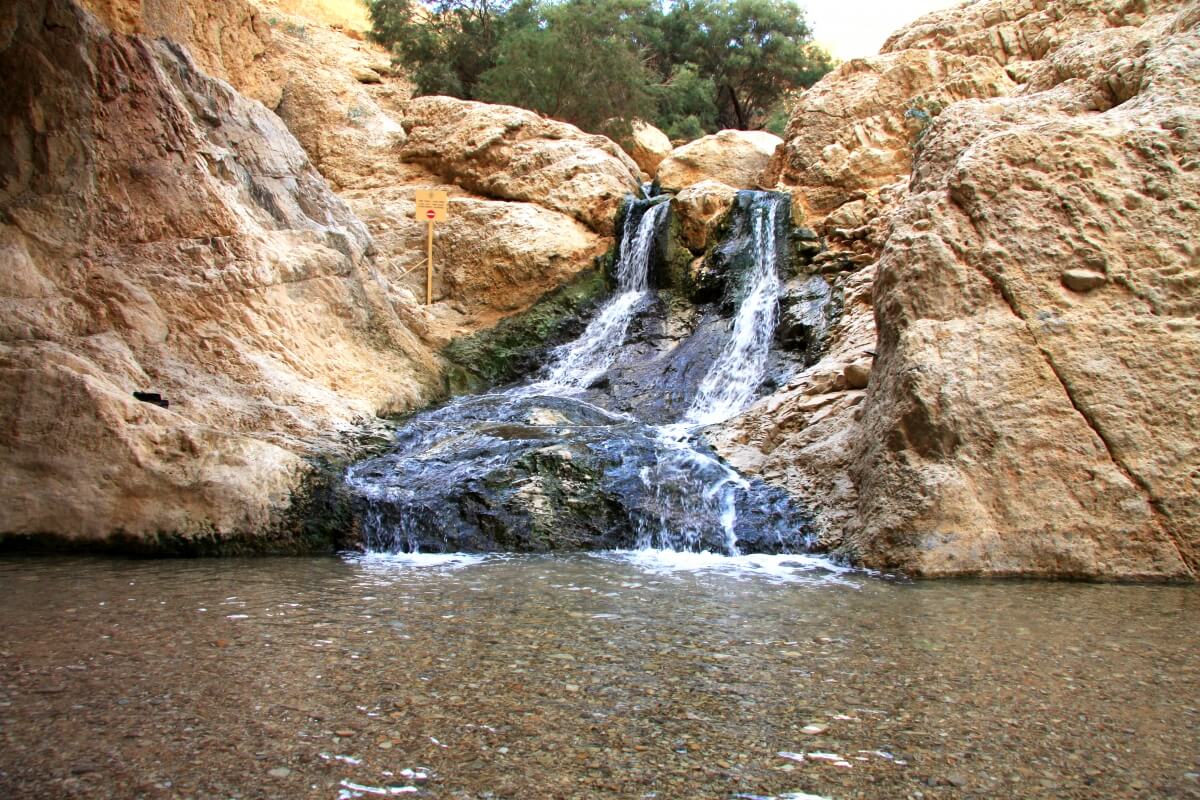Points of Interest
- Wading Pools in Bokek Stream – A beautiful water trail between narrow canyon walls.
- Bokek Fortress – Remains of an ancient fortress from the Roman Empire period.
- Ancient Aqueduct – A Roman-Byzantine irrigation system.
- Fascinating Geological Phenomena – An area rich with fault lines from the Dead Sea Rift.
- Variety of Desert Wildlife – Rock rabbits, Tristram’s starlings, little green bee-eaters, and more.
Details of Points of Interest
Wading Pools in Bokek Stream
Along the winding stream channel, flanked by high canyon walls, freshwater flows, allowing for bathing and refreshment. The trail through the stream involves walking partly in shallow water, surrounded by lush desert oasis vegetation.
Note: The trail requires walking in water up to knee height.
Bokek Fortress
At the foot of the stream’s cliff lie the remains of an ancient Roman-Byzantine fortress, likely used to guard the agricultural farm that operated in the area. The fortress offers a unique vantage point over the Dead Sea Valley.
Ancient Aqueduct
Remnants of an aqueduct that channeled water from the spring to the agricultural fields at the stream’s outlet testify to the area’s farming settlement. This water system was essential for growing date palms and unique perfume plants like balsam.
Fascinating Geological Phenomena
The area is characterized by geological fault lines formed during the disintegration of the Dead Sea Rift. Along the trail, you can observe rock layers deformed during the creation of the Syrian-African Rift.
Scenic Lookouts
- Bokek Fortress Lookout – A breathtaking panoramic view of the Dead Sea Valley, Moab Mountains, and Ein Bokek hotels.
- Escarpment Cliff Lookout – A vantage point over the flowing stream and the Dead Sea Works.
Identity Card
- Location: Southern Judean Desert, near the Ein Bokek hotels.
- Reserve Area: Approximately 2,000 dunams (200 hectares).
- Main Historical Periods: Roman-Byzantine period.
- Access: The reserve is accessible by car, with parking near the trail.
Reasons for Designation
- Preservation of the unique desert oasis in the southern Judean Desert.
- Conservation of a rich ecosystem, including water-loving animals and vegetation.
- Restoration of water sources and reintroduction of the desert wheatear, which had disappeared from the area.
- Preservation of archaeological sites from the Roman-Byzantine period.
History and Archaeology
Thanks to the water flow in Bokek Stream, the area served as an agricultural hub during the Roman-Byzantine period. An ancient farm, a fortress guarding the region, and an aqueduct channeling water for field irrigation were discovered here. It is believed that the farm cultivated medicinal plants and dates for commercial use.
Flora and Fauna
Flora
The area combines hardy desert vegetation with desert oasis plants. Along the stream channel, you can find:
- Water Plants: Giant reed, tamarisk, common reed.
- Desert Plants: Oleander, Persian salvadora, spiraled acacia.
- Limestone Cliff Plants: Thorny caper, Syrian rockrose.
Fauna
The reserve is a habitat for a variety of wildlife:
- Mammals: Rock rabbits, gazelles.
- Birds: Tristram’s starlings, rock doves, little green bee-eaters.
- Reptiles: Desert snakes and lizards.
How to Get There?
- Waze Address: Ein Bokek Nature Reserve.
- Access by Private Vehicle: Organized parking near the reserve entrance.
- Trail Types:
- Easy Circular Trail – Entry and exit via the stream.
- Trail for Experienced Hikers – Climb to the escarpment cliff and descent back to Ein Bokek.
